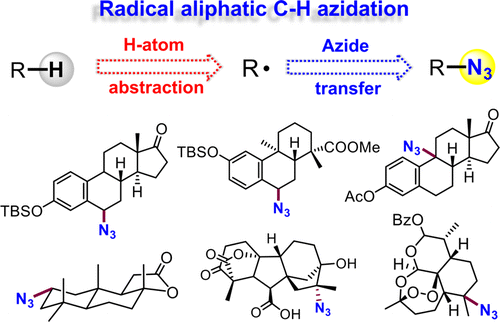当前位置:
X-MOL 学术
›
ACS Catal.
›
论文详情
Our official English website, www.x-mol.net, welcomes your
feedback! (Note: you will need to create a separate account there.)
Taming Azide Radicals for Catalytic C–H Azidation
ACS Catalysis ( IF 11.3 ) Pub Date : 2015-12-31 00:00:00 , DOI: 10.1021/acscatal.5b02474
Xiongyi Huang 1 , John T. Groves 1
ACS Catalysis ( IF 11.3 ) Pub Date : 2015-12-31 00:00:00 , DOI: 10.1021/acscatal.5b02474
Xiongyi Huang 1 , John T. Groves 1
Affiliation

|
Reactions that directly transform aliphatic C–H bonds into alkyl azides are noticeably lacking in the repertoire of synthetic reactions, despite the importance of molecules containing C–N3 bonds in organic synthesis, chemical biology, and drug discovery. Harnessing the ubiquity of C–H bonds in organic molecules and the versatility of the azide functional group, such transformations could have broad applications in various disciplines. Radical C–H activation represents an appealing strategy to achieve aliphatic C–H azidation, as it overcomes many drawbacks of conventional organometallic approaches in activating inert aliphatic C–H bonds. Novel C–H azidation methodologies could be realized by combining radical C–H activation via hydrogen atom abstraction with suitable azide-transfer reagents. In this perspective, we survey the history of radical C–H azidation and summarize several significant recent advances in the field. All radical C–H azidations to date follow a general approach comprising an initial radical C–H abstraction step and a subsequent azide transfer to the incipient carbon-centered radicals. A particular focus of this perspective is on the beneficial effects of using transition-metal catalysts in C–H azidation reactions, which have “tamed” azide radicals and led to reactions that proceed efficiently under much milder conditions and provide broader substrate scope and higher regioselectivities and stereoselectivities, compared to previous approaches.
中文翻译:

驯化叠氮化物自由基以催化C–H叠氮化
尽管含有C–N 3的分子很重要,但在合成反应中仍然缺少直接将脂肪族CH键转换为叠氮化物的反应。有机合成,化学生物学和药物发现中的化学键。利用有机分子中C–H键的普遍存在和叠氮化物官能团的多功能性,这种转化可以在各个学科中得到广泛应用。自由基C–H活化代表了实现脂肪族CH–H叠合的一种引人注目的策略,因为它克服了传统的有机金属方法在活化惰性脂肪族CH–H键方面的许多弊端。通过将氢原子提取的自由基C–H活化与合适的叠氮化物转移试剂结合起来,可以实现新颖的C–H叠氮化方法。从这个角度来看,我们调查了彻底的CH叠氮化的历史,并总结了该领域的一些重要最新进展。迄今为止,所有的C–H自由基均采用通用方法,包括最初的C–H自由基提取步骤和随后的叠氮化物转移至初期的以碳为中心的自由基。该观点的一个特别关注点是在C–H叠氮化反应中使用过渡金属催化剂的有益效果,该反应已“驯服”了叠氮化物自由基,并导致反应在更温和的条件下有效进行,并提供了更宽的底物范围和更高的区域选择性与以前的方法相比,具有更高的立体选择性。
更新日期:2015-12-31
中文翻译:

驯化叠氮化物自由基以催化C–H叠氮化
尽管含有C–N 3的分子很重要,但在合成反应中仍然缺少直接将脂肪族CH键转换为叠氮化物的反应。有机合成,化学生物学和药物发现中的化学键。利用有机分子中C–H键的普遍存在和叠氮化物官能团的多功能性,这种转化可以在各个学科中得到广泛应用。自由基C–H活化代表了实现脂肪族CH–H叠合的一种引人注目的策略,因为它克服了传统的有机金属方法在活化惰性脂肪族CH–H键方面的许多弊端。通过将氢原子提取的自由基C–H活化与合适的叠氮化物转移试剂结合起来,可以实现新颖的C–H叠氮化方法。从这个角度来看,我们调查了彻底的CH叠氮化的历史,并总结了该领域的一些重要最新进展。迄今为止,所有的C–H自由基均采用通用方法,包括最初的C–H自由基提取步骤和随后的叠氮化物转移至初期的以碳为中心的自由基。该观点的一个特别关注点是在C–H叠氮化反应中使用过渡金属催化剂的有益效果,该反应已“驯服”了叠氮化物自由基,并导致反应在更温和的条件下有效进行,并提供了更宽的底物范围和更高的区域选择性与以前的方法相比,具有更高的立体选择性。

































 京公网安备 11010802027423号
京公网安备 11010802027423号